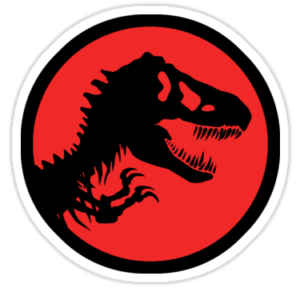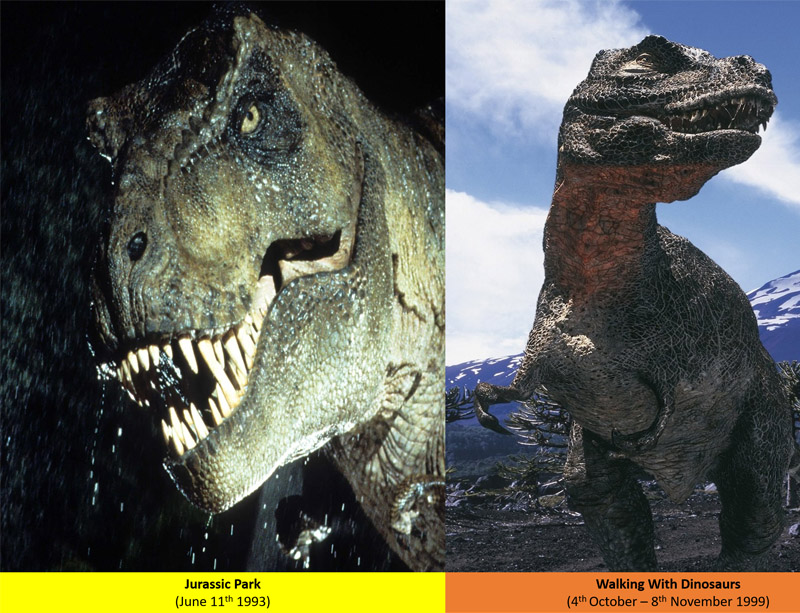
Originally penned by Michael Crichton and published in 1990, Jurassic Park began as a novel and later transformed into a gripping tale of a disastrous attempt to create a dinosaur-filled theme park through the power of cloning. Delving into the concept of cloning, the narrative echoes Crichton’s science fiction origins. Spielberg secured the movie rights before its publication, modifying the source material to intensify the cinematic experience while preserving its essence. The triumph of both the cinematic masterpiece and the literary work spawned a sequel, The Lost World, a title borrowed from (Sir) Arthur Conan Doyle’s novel of the same name. The Lost World is believed to have influenced Jurassic Park as both narratives revolve around dinosaurs. However, in (Sir) Doyle’s novel, the plot unfolds in South America, where the creatures’ survival is through anquity. In contrast, Crichton’s version involves the revival of dinosaurs through cloning. Notably, Spielberg also transformed this sequel into a cinematic masterpiece.
Tim Haines, the creator of behind Walking With Dinosaurs, found his inspiration in Jurassic Park when conceiving a documentary centered around dinosaurs. This revelation came to him three years following the film’s premiere. The surge of public fascination with dinosaurs ignited by Jurassic Park served as the impetus. Tim Haines’ brainchild was a wildlife program dedicated to prehistoric times, a realm where these magnificent creatures roamed. While crafting Walking With Dinosaurs, the creators aimed for authenticity, diverging from Jurassic Park’s portrayals. Their wellspring of inspiration extended to The Lost World‘s cinematic interpretation (from 1925) as well. To enrich their vision, they explored Crystal Palace Parks in London, renowned for their captivating albeit inaccurate displays of dinosaurs and prehistoric fauna dating back to the 1850s. Unlike Jurassic Park’s exclusive focus, Walking With Dinosaurs also embraced the inclusion of contemporaneous reptiles, mammals, and birds, crafting a comprehensive prehistoric panorama.

Both Jurassic Park and Walking With Dinosaurs are produced and distributed by popular companies, the former by Universal Studios and the latter by BBC. However, Jurassic Park, produced by Universal Studios, is a full-length feature film without narration, while Walking With Dinosaurs, produced by BBC, is a six-part television series narrated by Kenneth Branagh. Samuel L. Jackson portrayed Ray ‘John’ Arnold in Jurassic Park, after Morgan Freeman declined the role. Similarly, David Attenborough declined narrating Walking With Dinosaurs and was replaced by Branagh.

In 1990, the publication of Jurassic Park marked the start of a journey that began with its immediate film rights. Steven Spielberg, captivated by the story, acquired these rights even before the ink dried. This led him to visualize the tale through storyboarding, while Michael Crichton, the book’s creator, was commissioned to craft a screenplay. Spielberg, well-acquainted with the wizardry of ILM, the team behind Star Wars, approached them for their expertise. A quartet of visionary minds emerged: Stan Winston, tasked with dinosaur design; Phil Tippet, who brought forth models as the foundation; Michael Lantieri, overseeing their lifelike actions; and Dennis Muren, the maestro behind the CGI dinosaurs. ILM’s test footage showcased a thrilling chase – a tyrannosaurus pursuing gallimimus – and this spectacle, along with dynamic raptor and other tyrannosaurus scenes, secured their place in the movie. Filming spanned from August to November 1992, followed by post-production in May 1993, culminating in the film’s eagerly awaited release. Spielberg’s absence during post-production was due to his dedication to directing “Schindler’s List,” a cinematic masterpiece depicting German business Oskar Schindler’s valiant efforts to save persecuted Jews during the Nazi era.
Originating in 1996, the brainchild of Walking With Dinosaurs extended its reach over a span of three years. Spearheaded by Tim Haines, the venture saw him and Jasper James at its helm as the executive and primary producer respectively. While the initial consideration of ILM for VFX and CGI proved too costly, the reins were handed to Mike Milne from FrameStore. A tapestry of test footage featuring diverse dinosaurs like cetiosaurus, eustreptospondylus, liopleurodon, and a pterosaur was unveiled. Notably, one of these prehistoric creatures failed to secure a spot in the final iteration of the series. The year 1997 witnessed the commencement of filming, paving the way for post-production activities from 1998 to 1999. Finally, in the latter part of 1999, the series debuted.

Jurassic Park was primarily shot on the Hawaiian island of Kauai, along with extra filming at Universal Studios and nearby islands. Regarding Walking With Dinosaurs, it was filmed in various places including Chile, New Zealand, New Caledonia, Bahamas, and California, among others.

Jack Horner, who served as the inspiration for the character Alan Grant in the book that inspired Jurassic Park (where the character was portrayed by Sam Neill in the movie), played a crucial role as a technical advisor during the making of the film. He guided the director and crew to emphasize the idea that dinosaurs are closer to birds than reptiles in reality.
In contrast, Walking With Dinosaurs had several paleontologists, including Michael Benton, Thomas R. Holtz, Jr., Peter Dodson, Peter Larson, David Martill, and James Farlow, who acted as technical advisors for the show.

Jurassic Park and Walking With Dinosaurs are famous for their revolutionary methods in Computer-Generated Imagery, or CGI. A significant similarity in their production involved creating initial scenes that the digital animals would later seamlessly inhabit. These scenes included moving trees that dinosaurs would pass through, water splashes, and object interactions, all of which were later completed by computer-generated creatures. Closeup shots of certain dinosaurs involved puppetry. However, Jurassic Park‘s CGI was finalized a month before the film’s release, while Walking With Dinosaurs took two years for its CGI to be completed. Another distinction is in the process: Jurassic Park used scanning to turn dinosaur models into CGI images, whereas Walking With Dinosaurs scanned dinosaur models first before incorporating them into the digital environment.

To gain a deeper understanding of how dinosaurs behaved, both the creators of Jurassic Park and Walking With Dinosaurs sought inspiration from nature. They observed animals like elephants, giraffes, rhinos, and ostriches to replicate movements for different dinosaurs. Among these, the study of elephant movements as well as those of giraffes played a significant role in bringing the brachiosaurus to life in Jurassic Park. Similarly, Walking With Dinosaurs also drew from nature, especially in Episode 2, where elephant movements were used to depict the smaller sauropod diplodocus. The creators also looked at birds in flight for pterosaur movements and orca whales catching seals for a reference in portraying a liopleurodon capturing an eustreptospondylus. However, it is noteworthy that unlike Jurassic Park, Walking With Dinosaurs primarily avoided using human movements, except when depicting dinosaur footprints being formed by the crew using toys that represented dinosaur prints.

Walking With Dinosaurs references Jurassic Park in terms of both the novel and film
1. Episode 2 showcases Diplodocus, closely connected to apatosaurus from the Jurassic Park book. Additionally, Brachiosaurus, featured in the same episode, was also in the Jurassic Park movie, taking the place of Apatosaurus.
2. In Episode 4, the Utahraptor looks similar to, and is also related to the velociraptor that appears in both the Jurassic Park, book and movie. Both are dromeosaur. The raptor that inspired the name for this dinosaur family and whose other name is deinonchys or dakotaraptor is also in Episode 6.
3. The well-known Tyrannosaurus, a star in both the Jurassic Park books and movies, also takes the spotlight in the final episode of Walking With Dinosaurs. The BBC reveals that ‘Rex’ is a nickname for this dinosaur, whose true name is simply ‘Tyrannosaurus’. While the Stegosaurus appears in Walking With Dinosaurs, it is absent from the first Jurassic Park movie. However, it features in the novel adaptation and its sequel, as well as the film version of the sequel book. The Triceratops, found in both Jurassic Park works and movies, as well as the last episode of Walking With Dinosaurs, is connected to Torosaurus, another important dinosaur in the show although only a dead Triceratops appears in the show. In both franchises, there is a sequence involving the Tyrannosaurus hunting hadrosaurs, shown in the novels and the final Walking With Dinosaurs episode. Moreover, the defense of Triceratops against velociraptors to protect their young in the second Jurassic Park novel sharply contrasts with the fate of a young Torosaurus against deinonychus in Walking With Dinosaurs. In the latter situation, the Torosaurus are unable to rescue their young from the raptors, unlike the successful efforts of the Triceratops in saving their young from the raptors. The position of the deceased triceratops in episode 6 resembles the sick triceratops in the film version of Jurassic Park, where it takes the place of the ailing Stegosaurus from the book.

Certainly, nobody really knows how dinosaurs sounded. In Jurassic Park, the team tried to guess the sounds based on the animals’ traits. They recorded various animal sounds, with the most remarkable being those for the main characters: velociraptors and tyrannosaurus. Velociraptors’ sounds were a mix of dolphin screams and walrus bellows, while the tyrannosaurus’ sounds were created by blending elephant and tiger sounds as well as those of Lions. Unlike Jurassic Park, Walking With Dinosaurs chose a different approach. They recorded sounds from animals not used in Jurassic Park. For instance, the tyrannosaurus’ sound was a blend of bear and bird, and the raptors’ sounds were similar to bird screams although crane sounds were briefly used for the raptors in Jurassic Park.

Just like many of Steven Spielberg’s movies, John Williams composed the music for Jurassic Park. However, Spielberg couldn’t be there during the music recording because he had to go to Poland to film Schindler’s List. He supervised the special effects from the US through videos and received audiotapes for the music. In contrast, Tim Haines and Jasper James, who directed Walking With Dinosaurs, were there in person for its score by Ben Bartlett.

Release
Jurassic Park first debuted on June 11, 1993, receiving enthusiastic reviews and drawing massive audiences. The film sparked a renewed fascination with ancient history, especially the captivating world of dinosaurs. This resurgence of interest was similarly seen in Walking With Dinosaurs, a television series that aired from October 4, 1999, until November 8 of the same year.

Jurassic Park won three academy awards in the categories of Best Sound Mixing, Best Sound Editing, and Best Visual Effects. It achieved the same feat at the BAFTA awards, securing victory in those three categories. Similarly, Walking With Dinosaurs clinched two BAFTA awards and two Emmy Awards, mirroring Jurassic Park‘s Oscar count. Nonetheless, Walking With Dinosaurs stands apart by also earning an Emmy award for its remarkable score.

